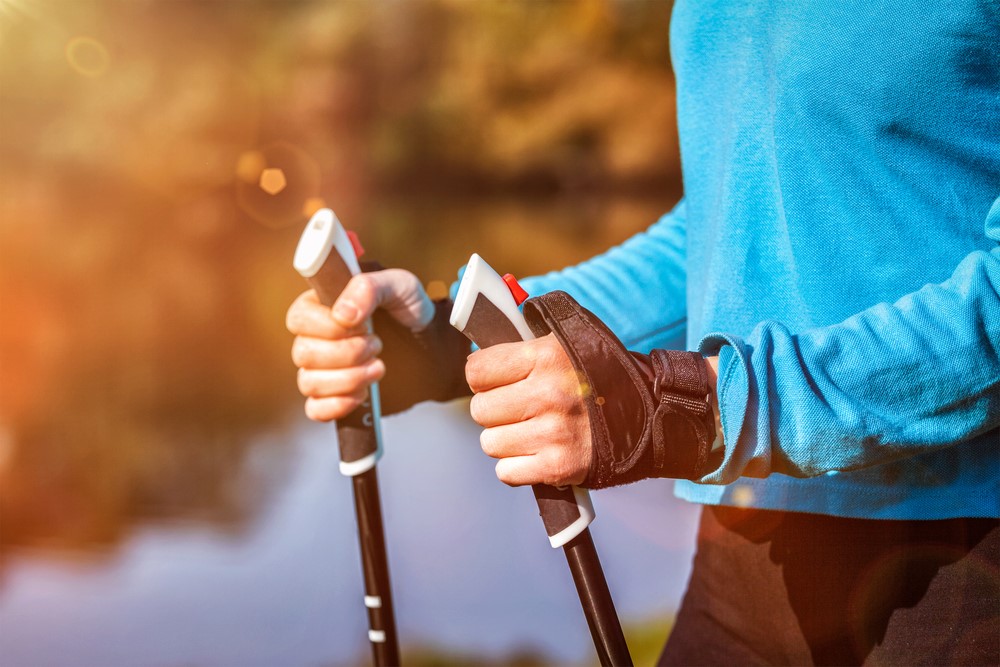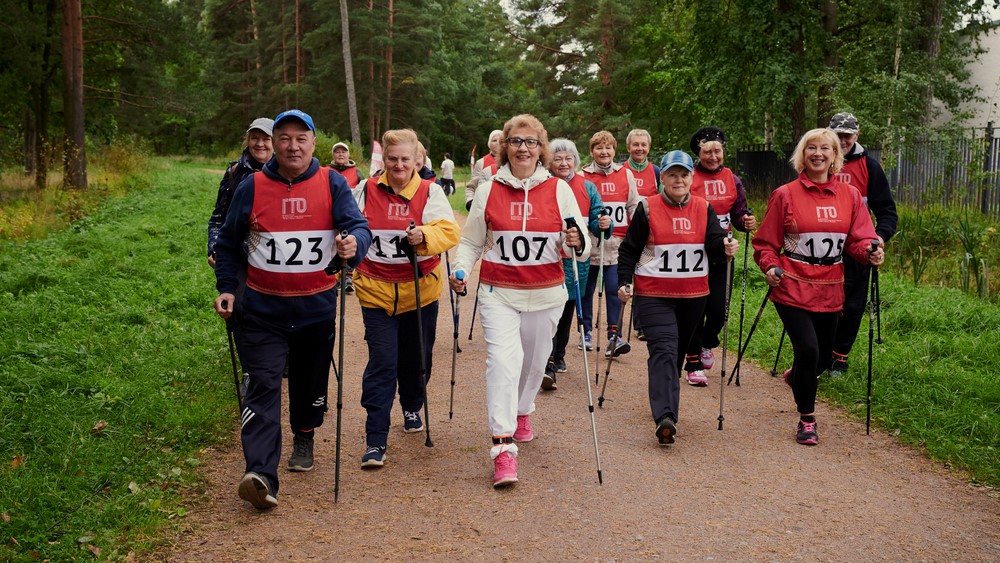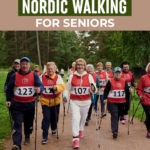
So, you’re interested in Nordic walking for seniors? The practice offers many benefits, as it involves more muscle engagement than regular walking, while supporting your joints and promoting a good posture at the same time.
However, as with many things, some Nordic walking approaches are better than others. Following a poor technique or using the wrong type of poles could even put you at risk.
Whether you’re a senior, a caregiver, or someone else, the tips we’re highlighting in this post will help you get the most out of your Nordic walking. We’ve included a few videos too, so that you can see exactly what to expect.
Best Practices with Nordic Walking for Seniors
- Use A Good Technique
- Choose The Right Poles
- Make It A Social Activity
- Commit To Walking Regularly
- Increase The Walk Length Over Time
- Vary The Intensity
Use A Good Technique
Nordic walking is more than just having two walking sticks with you while you walk. You’re trying to engage your body, so the way you use the sticks makes a huge difference.
The video below shows the basic technique for walking with ACTIVATOR poles (although you can walk much faster than she does in the video). These ACTIVATOR poles made Nordic walking famous, but you can use other types of poles too.
Another video (below) shows a distinctive style of walking. This time you’re not using the poles for support, but you’re somewhat dragging them instead. The style engages your body more than supporting yourself with the poles, but you’ll need to experiment to find out which approach works best for you.
There’s also a more comprehensive video that steps you through more details about urban poling (that’s just another word for Nordic walking), including ways to adjust the poles and other tips.
That second technique, where you have the poles behind you, is the one that’s commonly discussed for most situations, including Nordic walking for seniors. It’s the most powerful technique, but it might not work well if you’re likely to need some support from the poles.
In the end, you’ll need to choose the technique that works best for you.
Choose The Right Poles
The poles that you use matter as well. The ACTIVATOR poles we mentioned earlier are perhaps the best choice, as these were designed by a physical therapist and are meant to be used in this way.
In contrast, most other types of poles are developed for hiking or as generic poles for a variety of uses. Because of this, other poles won’t have all the same features and may not be as safe.
Plus, studies have looked at these poles, finding them to be effective at promoting exercise and improving some health outcomes.
Regardless of the type you choose, keep the following things in mind:
- Make sure the pole has a sturdy base. The best ones have a type of gripped foot so that they work well on concrete. Don’t forget that most hiking poles rely on spikes to dig into the ground. Some have gripped attachments too, but others don’t. While the spikes might be okay if you’re out on trails, they’re useless when you’re walking on concrete, so make sure you have something appropriate for your situation.
- Find poles that are the right height. Adjustable poles are an easy approach here. Alternatively, some companies will custom create a pole for you based on your height. If you’re shopping in person (rather than online), you can even test out the pole for yourself to make sure it’s perfect.
- The best sticks will have ergonomic handles, ones that are easy to hold onto without using a strap. While straps help you to avoid dropping the pole, they increase the risk that you’ll get caught up with the stick and hurt yourself if you fall.
- If you need to lean on the stick, make sure it is weight bearing. The company should provide details about the amount of weight the pole can handle and you should test this carefully for yourself too.
- Pay attention to reviews. Reviews are crucial, as poles for walking look similar to one another, but quality can vary dramatically. Be even more careful with adjustable poles, as some of these are poor-quality and may collapse under weight.
Make It a Social Activity

One of the best ways to stay active is to get other people involved. It’s far too easy to skip your regular walk if you’re the only person who knows whether you go or not. Joining in with other people can give you a sense of obligation, making it easier to get out the door.
Nordic walking is popular enough that there are many regular walking groups. If you can’t find one that suits you, why not start one of your own?
Or, why not find a single person to go with you? Buddying up for walking gives you the chance to talk along the way and is an excellent way of growing a friendship. Plus, in this COVID-19 era, walking with one other person may be safer than a full group.
You might even bring along a family member. Nordic walking could be excellent for seniors and their adult children, giving them a chance to be active and spend time together.
Commit to Walking Regularly
Many of us want to stay active, but actually doing so is an entirely different story.
It’s easy to put off exercising. To say that we’ll do it another day or that we simply ‘don’t feel like it’. Doing so starts to be a problem fast, as we don’t get the exercise that we need.
Committing to a routine can help – whether that’s walking for 10 minutes every day or something more challenging.
Some people benefit from having a set time that they walk. Walking with someone helps too, as you’re no longer just accountable to yourself.
Increase The Walk Length Over Time
Nordic walking is a low intensity exercise, but this doesn’t mean that you should be casual about it. You’ll see more benefits by gently pushing your limits.
The simplest way to do this is with the duration of your walk. Try making the walk a little longer each time, until you get to a length that you’re satisfied with. Some people recommend walking for around 50 minutes. That might seem like a long time, but the time should fly if you walk with friends or put on some good music.
Walking for 50 minutes or longer is useful for seniors for another reason too – it helps to break up the day. After all, being retired often means that people have more time on their hands and few tasks to occupy their day with. Regular decent walks can help to make things much more interesting.
Besides, Nordic walking for seniors is a perfect way to get people outside and into the fresh air. Doing this regularly might reduce the risk of depression, improve mood, and have countless other benefits.
Longer walks can be beneficial too. Some people end up walking for two hours or even more, particularly if they’re exploring an unfamiliar environment. But, even if you’re confident, it’s important to start slowly. Going from nothing to a long walk can leave you aching and might make it tough to get back out there.
Instead, start with 30 minutes or even less. You can increase the time as you go.
Vary The Intensity
You can make Nordic walking a more intense experience by increasing the length of your strides, walking faster, or moving your arms more. Doing so can increase the amount of calories you burn and give your muscles a better workout.
One way to do this is to alternate between regular walking and long Nordic strides every 15 minutes or so. This provides you with periods of relatively intense exercise and slower periods where you can recover.
Choose The Location Based On Your Needs
Walking with poles is a great way to explore the countryside. The poles are especially helpful when the terrain is a bit rough.
But, this isn’t your only option. Nordic poling for seniors has become popular around the cities too. You’ll often see groups of seniors walking together with their poles. Such groups are fantastic ways to stay connected socially, while helping seniors to stay active as well.
Be Careful With The Strap
Most walking poles have straps. These make it easy to hold onto the stick and reduce the risk that you’ll drop it.
Poles for Nordic walking tend to be similar (except the ACTIVATOR poles that we mentioned earlier).
While the straps have their uses, they’re also risky. They can easily lead to injuries. For example, if you drop the pole or get it caught while you’re still attached to it, the strap could easily make you fall as well.
ACTIVATOR poles get around the problem by designing the handle so that it’s easy to grip without a strap. If you’re not using this type of pole, look for one with a quick release strap instead.
And, if that’s not an option, make sure that you’re cautious while you’re walking. You could even ignore the strap altogether and just use the handle of the stick. Doing so might make you drop the stick a little more often, but that’s much better than having a fall.
Feeling Overwhelmed?
Check out our Caregiving Consulting service for personalized support and guidance.


Leave a Reply